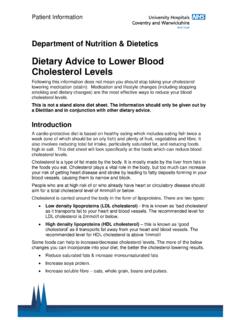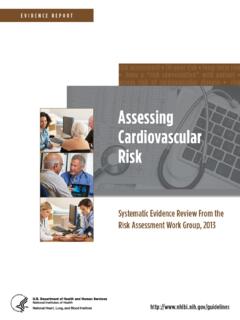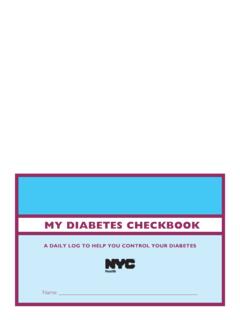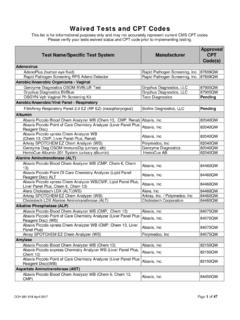Transcription of Laboratory Procedure Manual
1 Laboratory Procedure Manual Analyte: Total cholesterol , HDL- cholesterol , Triglycerides, and LDL- cholesterol Matrix: Serum Method: Hitachi 704 Analyzer which is serviced by Roche Diagnostics (formerly Boehringer-Mannheim Diagnostics), Indianapolis as performed by: Lipid Laboratory Johns Hopkins University School of Medicine Lipoprotein Analytical Laboratory 600 North Wolfe Street Blalock 1379 Baltimore, MD 21287 410-614-1030 Contact: Peter O. Kwiterovich, Jr., Total cholesterol , Direct HDL, Precipitated HDL, Triglycerides, and LDL NHANES 2003-2004 Public Release Data Set Information This document details the Lab Protocol for NHANES 2003-2004 data. A tabular list of the released analytes follows: Lab Number Analyte SAS Label (and SI units) LBXTC Total cholesterol (mg/dL) LBDTCSI Total cholesterol (mmol/L) LBXHDD HDL- cholesterol (mg/dL) LBDHDDSI HDL- cholesterol (mmol) LBXTR Triglycerides(mg/dL) l13_c LBDTRSI Triglycerides(mmol/L Page 2 of 23 Total cholesterol , Direct HDL, Precipitated HDL, Triglycerides, and LDL NHANES 2003-2004 1.)
2 SUMMARY OF TEST PRINCIPLES AND CLINICAL RELEVANCE A. Total cholesterol cholesterol is measured enzymatically in serum or plasma in a series of coupled reactions that hydrolyze cholesteryl esters and oxidize the 3-OH group of cholesterol . One of the reaction byproducts, H2O2 is measured quantitatively in a peroxidase catalyzed reaction that produces a color. Absorbance is measured at 500 nm. The color intensity is proportional to cholesterol concentration. The reaction sequence is as follows: cholesteryl ester hydrolase Cholesteryl ester + H2O ------------------------------------->ch olesterol + fatty acid cholesterol oxidase cholesterol + O2 ----------------------------> cholest-4-en-3-one + H2O2 peroxidase 2H2O2 + 4-aminophenazone + phenol ---------------------> 4-(p-benzoquinone- monoimino)-phenazone + 4 H2O Elevated levels of cholesterol increase the risk for coronary heart disease (CHD).
3 cholesterol is measured to help assess the patient's risk status and to follow the progress of patient's treatment to lower serum cholesterol concentrations. Desirable cholesterol levels are considered to be those below 200 mg/dL in adults and below 170 mg/dL in children. B. Triglycerides Triglycerides are measured enzymatically in serum or plasma using a series of coupled reactions in which triglycerides are hydrolyzed to produce glycerol. Glycerol is then oxidized using glycerol oxidase, and H2O2, one of the reaction products, is measured as described above for cholesterol . Absorbance is measured at 500 nm. The reaction sequence is as follows: lipase Triglycerides + 3H2O ------------> glycerol + fatty acids glycerokinase Glycerol + ATP ----------------------> glycerol-3-phosphate + ADP glycerophosphate oxidase Glycerol-3-phosphate + O2 ------------------------------> dihydroxyacetone phosphate + H2O2 peroxidase H2O2 + 4-aminophenazone + 4-chlorophenol -------------> 4-(p-benzoquinone-monoimino)- phenazone + 2H2O + HCl.
4 High levels of serum triglycerides help mark conditions that are associated with increased risk for CHD and peripheral atherosclerosis. High triglycerides are associated with increased risk for CAD in patients with other risk factors, such as low HDL- cholesterol , some patient groups with elevated apolipoprotein B concentrations, and patients with forms of LDL that may be particularly atherogenic. Desirable fasting triglyceride levels are considered to be those below 200 mg/dL, and are further categorized as Borderline, 200-400 mg/dL; High, 400-1,000 mg/dL; and Very High (> 1000 mg/dL). Very high triglycerides can result in pancreatitis and should be promptly evaluated and treated. Triglycerides are also measured because the value is used to calculate low density lipoprotein (LDL)- cholesterol concentrations (see below). In NHANES 2003-2004, Page 3 of 23 Total cholesterol , Direct HDL, Precipitated HDL, Triglycerides, and LDL NHANES 2003-2004 triglycerides are only measured in specimens from fasting participants, , those sampled in Session 1.
5 C. High density lipoprotein (HDL) cholesterol Low serum concentrations of HDL- cholesterol are associated with increased risk for CHD. Coronary risk increases markedly as the HDL concentration decreases from 40- to 30 mg/dL. A low HDL- cholesterol concentration is considered to be a value below 35 mg/dL, and high HDL, >60 mg/dL. HDL- cholesterol values are also used in the calculation of LDL- cholesterol (see LDL section below). Direct HDL method. HDL is measured directly in serum. The basic principle of the method is as follows. The apoB containing lipoproteins in the specimen are reacted with a blocking reagent that renders them non-reactive with the enzymatic cholesterol reagent under conditions of the assay. The apoB containing lipoproteins are thus effectively excluded from the assay and only HDL-chol is detected under the assay conditions.
6 The reagents are purchased from Roche/Boehringer-Mannheim Diagnostics. The method uses sulfated alpha-cyclodextrin in the presence of Mg+2, which forms complexes with apoB containing lipoproteins, and polyethylene glycol-coupled cholesteryl esterase and cholesterol oxidase for the HDL- cholesterol measurement. The reactions are as follows: (1) ApoB containing lipoproteins + -cyclodextrin + Mg+2 + dextran SO4 ---> soluble non-reactive complexes with apoB-containing lipoproteins (2) HDL-cholesteryl esters PEG-cholesteryl esterase > HDL-unesterified cholesterol + fatty acid (3) Unesterified chol + O2 PEG- cholesterol oxidase > cholestenone + H2O2 (4) H2O2 + 5-aminophenazone + N-ethyl-N-(3-methylphenyl)-N _succinyl ethylene diamine + H2O + H+ peroxidase > qunoneimine dye + H2O Absorbance is measured at 600 nm.
7 D. LDL- cholesterol Most of the circulating cholesterol is found in three major lipoprotein fractions: very low density lipoproteins (VLDL), LDL and HDL. [Total chol] = [VLDL-chol] + [LDL-chol] + [HDL-chol] LDL- cholesterol is calculated from measured values of total cholesterol , triglycerides and HDL- cholesterol according to the relationship: [LDL-chol] = [total chol] - [HDL-chol] - [TG]/5 where [TG]/5 is an estimate of VLDL- cholesterol and all values are expressed in mg/dL. LDL carries most of the circulating cholesterol in man and when elevated contributes to the development of coronary atherosclerosis. LDL- cholesterol is measured to assess risk for CHD and to follow the progress of patients being treated to lower LDL- cholesterol concentrations. Desirable levels of LDL-chol are those below 130 mg/dL in adults and 110 mg/dL in children.
8 In NHANES 2001-2002, LDL-chol will be reported only for fasting participants >5 years of age. 2. SAFETY PRECAUTIONS A. Daily Safety Precautions. All personnel working in the Laboratory must wear gloves and Laboratory coats. Laboratory coats are to be kept buttoned. Gloves are removed when leaving the immediate work area or when entering offices within the immediate work area. All used Page 4 of 23 Total cholesterol , Direct HDL, Precipitated HDL, Triglycerides, and LDL NHANES 2003-2004 gloves, vials, pipettes and other items that come in contact with specimens are disposed of in a Biohazard box lined with a red plastic bag. Such biohazardous waste is picked up each day by housekeeping for proper disposal. Work benches are cleaned at the end of each day with a solution of sodium hypochlorite (bleach:water, 1:100, v/v) and then covered with plastic-backed white paper.
9 B. Blood Handling. The improper handling of blood samples from patients with infectious diseases, , hepatitis or HIV, can lead to infection of staff that draw, handle, analyze or store such samples. Transmission can occur by ingestion, inhalation or direct contact, and staff must exercise care when handling blood samples. Always wear liquid impermeable gloves ( , latex or plastic) when handling biological samples. Never pipet samples by mouth. Avoid contact with serum. Cover any scratches or cuts on fingers and hands and wear gloves before handling serum. Store all samples in sealed containers. In order to minimize the formation aerosols, do not leave samples open to the atmosphere longer than necessary. It is about 30 times easier to become infected with hepatitis than with HIV through sample mishandling, and it has been recommended that the usual precautions for handling blood specimens to prevent hepatitis infection serve as a guide to prevent AIDS infection as well.
10 Handle all specimens as if you know them to be infectious. All staff should adhere to the CDC Guidelines for Prevention of HIV Infection in Health Care Workers. C Spills. The contaminated area is cleaned with a solution of sodium hypochlorite (bleach:water, 1 :100, v/v) and the wipes are disposed of in a red biohazard bag. 3. COMPUTERIZATION; DATA SYSTEM MANAGEMENT Sample identifying information is received via a closed E-mail system from the NCHS data repository (WESTAT) the same day the samples are received in the Laboratory from the MEC. The E-mail sample information is downloaded into a working Laboratory database (referred to here as the NHRDR database) and computerized run lists are created for the automated analyzer. When an analytical run is completed, the analytical data are downloaded from the analyzer in the form of ASCII text files, which are then converted to a database and uploaded to the NHRDR database.
















